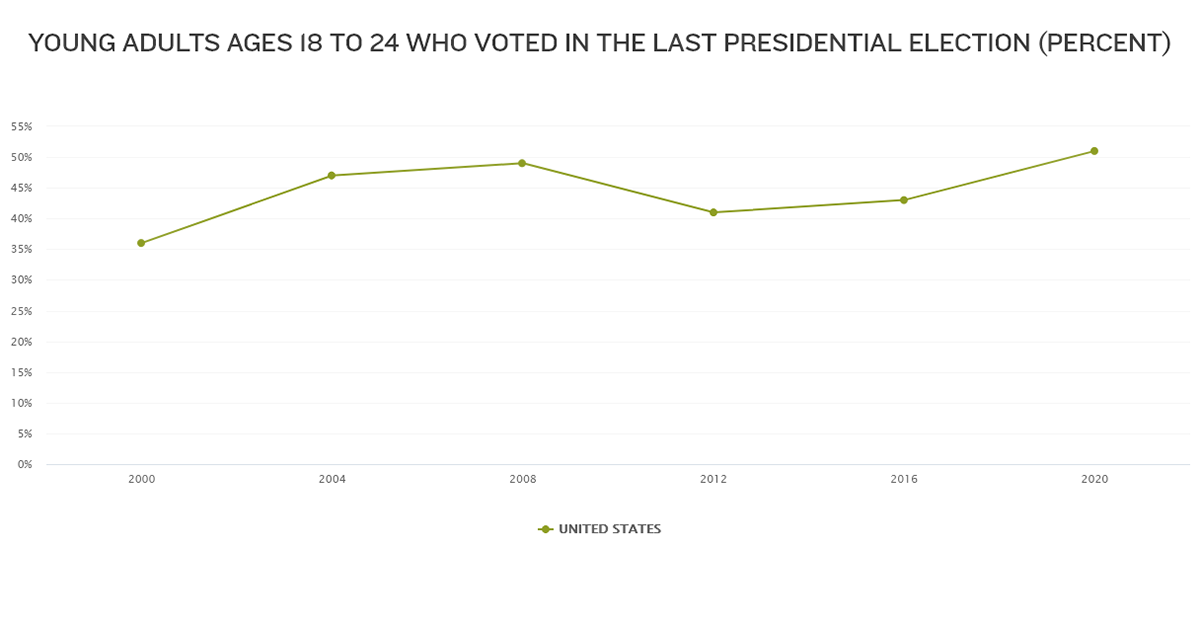Just Over Half of Young Adults Voted in the 2020 Presidential Election. Will Gen Z Exceed That in 2024?

Every election season, much public discussion focuses on voter turnout, particularly for young adults who have demonstrated impressive civic engagement in recent elections. According to the KIDS COUNT Data Center, 51% of young adults ages 18 to 24 voted in the 2020 presidential election, a large increase from 43% in 2016. Since the start of the century — when the turnout rate was just 36% in 2000 — the youth vote has generally trended upward in presidential elections. The number of young adults who vote has also grown from about 8.6 million in 2000 to nearly 13.8 million in 2020.

Youth civic engagement activists and leaders are working hard to maintain this momentum in 2024, with a focus on Generation Z, as it currently spans ages 12 to 27. Members of this generation made up one-tenth of the 2020 electorate and added 8.3 million newly eligible voters since November 2022 — reaching an estimated 41 million total eligible voters in 2024.
Trends for Young Adult Voting in Midterm Elections
Generally, turnout in midterm elections is lower for all voting age groups compared to presidential elections. Among young people ages 18 to 24, more than 1 in 4 (28%) voted in the 2022 midterm, slightly below the 2018 rate (32%), but substantially above the 2014 rate (17%). The 2018 midterm broke records for its high turnout among all age groups, and young adults were widely credited for their extraordinary engagement that year. Youth turnout in 2022 was not far behind the 2018 record, though, and some experts report that the 2022 midterm had the second-highest youth voting rate in nearly three decades.
It is critical to maintain these gains in active young voters, as they are important civic participants, and empowering them to vote benefits their lives and our democracy.
State Differences in Young Adult Voter Turnout
Over the last two decades, most states with available data saw increases in young adult voter turnout in both the midterm (2002–2022) and presidential (2000–2020) elections. However, the young voter turnout varies widely from state to state and election to election within each state.
Among states with available data in 2020, estimates of young adults who voted in the presidential elections ranged from nearly one-third in Oklahoma (31%) and Arkansas (32%) to more than two-thirds in Minnesota (69%), Maryland (71%) and New Jersey (75%). State-level turnout in prior presidential elections was markedly lower, with 2016 figures spanning 22% to 61%, for example.
In the 2022 midterm, only 1 in 7 young adults voted in Nebraska and West Virginia (both 14%), compared to nearly half in Wisconsin (49%) and Michigan (46%). In the previous 2018 midterm, youth civic engagement was much higher, with turnout ranging from a low of 21% to a high of 48%, among states with data.
Why Does Voting and Civic Engagement Matter for Young Adults?
When young people play an active role in elections or other policy change efforts, they develop skills and knowledge, and they become empowered to help shape their futures, strengthen their communities and contribute to democracy. In elections, they vote for policies that they believe will help them and their families succeed, whether it is related to financial security, health care, reproductive freedom, climate change, safety, equality, education or other issues. Civic engagement creates valuable leadership skills, which can help youth and young adults thrive throughout their lives.
Learn More on Youth and Young Adult Civic Engagement & Other Issues
These data on voting trends are continually updated in the KIDS COUNT Data Center, along with 60-plus other indicators about youth and young adults, including teen participation in community service or volunteer work. This dataset is part of the Annie E. Casey Foundation’s Thrive by 25 focus, which works to ensure that all young people have what they need to realize their full potential.
Explore more of our blog posts and publications related to this topic and Generation Z:
- Early Lessons in Engaging Youth and Adults in Community Change Efforts
- How Young Adults View Social Connectedness and Access Resources
- Case Studies for Supporting Youth Leadership and Economic Opportunity
- A National Profile of Youth and Young Adults
- Core Characteristics of Generation Z
- Social Issues That Matter to Generation Z
- What the Statistics Say About Generation Z
In addition, the Center for Information and Research on Civic Learning & Engagement at Tufts University, a nonpartisan research organization focused on youth civic engagement, is a useful resource on this topic.
Stay Connected
Sign up for our newsletters to get the latest data, reports and other resources.






